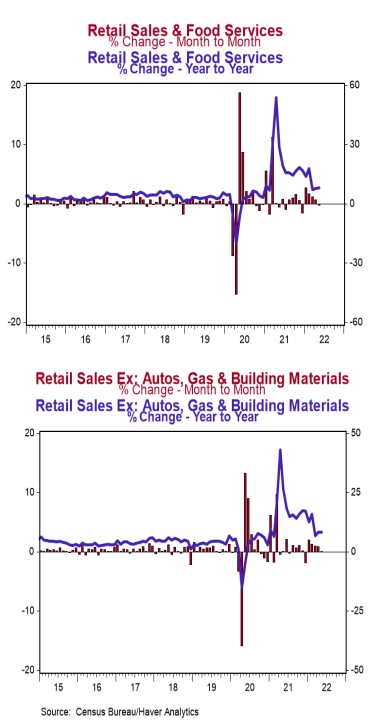- Retail sales declined 0.3% in May (-0.7% including revisions to prior months) versus a consensus expected a gain of 0.1%. Retail sales are up 8.1% versus a year ago.
- Sales excluding autos rose 0.5% in May (+0.2% including revisions to prior months), coming in below the consensus expected gain of 0.7%. These sales are up 11.2% in the past year. Excluding gas, sales declined 0.7% in May but are up 5.3% from a year ago.
- The drop in sales in May was led by autos and non-store retailers (internet and mail-order). The largest gain was for gas stations.
- Sales excluding autos, building materials, and gas rose 0.1% in May, but including prior months' revisions were down 0.5%. If unchanged in June, these sales will be up at an 8.1% annual rate in Q2 versus the Q1 average.
Implications:
Retail sales declined 0.3% in May and were revised lower for April, the first drop in five months. Moreover, the decline is even before inflation is factored in. On a "real" (inflation-adjusted) basis, retail sales declined 1.3% in May. Although nominal retail sales are up 8.1% from a year ago, that pace lags inflation, too, with the CPI up 8.6% over the same period. Six of the thirteen major sales categories declined in May, led by autos and non-store retailers. Supply-chain issues are still a major problem for the auto sector. In addition, auto sales also likely face a headwind from higher gas prices. Traditionally, many consumers think of their transportation costs on a combined basis, so lower gas prices often coincide with higher auto sales and higher gas prices with lower auto sales. The largest gain in sales in May was at gas stations, mainly due to higher prices at the pump. "Core" sales, which exclude the most volatile categories of autos, building materials, and gas station sales, rose 0.1% in May, are up 8.2% from a year ago, and up 25.9% versus February 2020. Due to very loose monetary policy and the massive increase in government transfer payments in response to COVID, retail sales have been artificially lifted and are now trending back to normal. However, loose monetary policy, which helped finance that big increase in government spending, is translating into high inflation, which is why "real" (inflation-adjusted) retail sales are slightly down versus a year ago. What to expect in the months ahead? More reports on retail sales that lag inflation or, at best, barely keep up with it. Meanwhile, look for modest overall gains in consumer spending due to the service sector. In other news this morning, import prices rose 0.6% in May while export prices increased 2.8%. In the past year, import prices are up 11.7%, while export prices are up 18.9%. Expect prices to continue to trend higher in the months ahead due to the effects of the war in Eastern Europe and the very loose stance of monetary policy.





